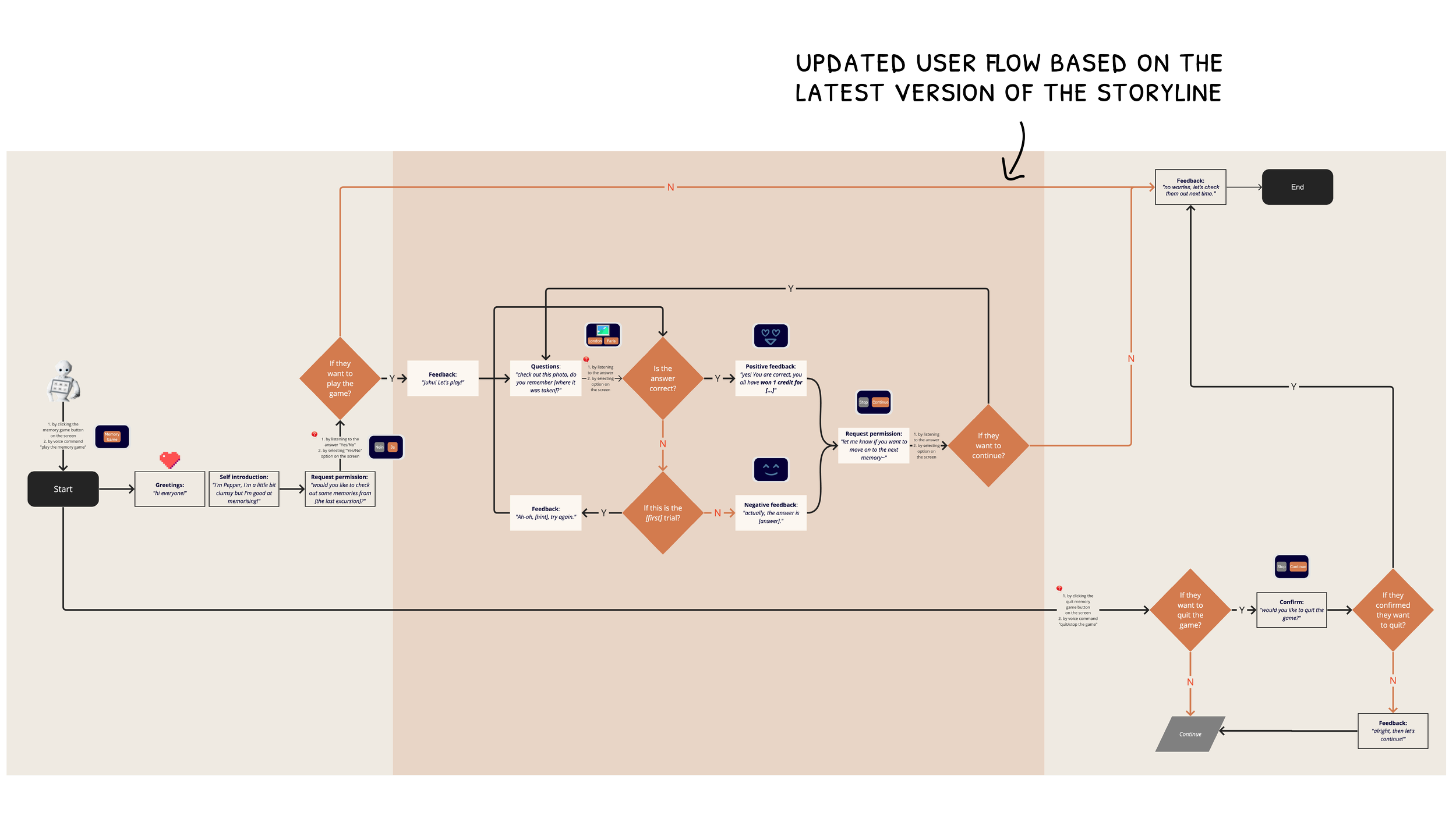
Erinnern Sie sich noch? (Do you remember?)
An interactive storytelling experience with Pepper for Older Adults' Memory Training
USER EXPERIENCE | USER RESEARCH | USER INTERFACE | VOICE INTERACTION
TOOLS
Figma, Miro, Choreographe, HTML, CSS
GOAL
Create an engaging and interactive experience using robotics to enhance the day-to-day activities of older adults, supporting their well-being and reducing caregiver workload amidst Germany's evolving demographic challenge.
MY ROLE
UX Researcher & UX Designer
Qualitative interviews, Brainstorming, Storytelling, User Flow, Frontend and Choreographe programming, Prototyping, Field testing
Above | An overview of the project’s methodology
Empathize
Germany is facing a significant demographic challenge: the population of older adults is increasing, while there is a need for more caregivers. This situation raises an important question: how can we utilize technology to support caregivers? One exciting possibility is using robotics, particularly with engaging humanoid robots like Pepper.
Going to the source.
We started our journey by trying to understand the context of our users—both the adults and caregivers in care facilities. We visited two care facilities and conducted semi-structured interviews with both user groups with great caution, particularly due to the ongoing presence of COVID-19 at that time. Our goal was to learn about the activities that adults and caregivers engage in, the challenges they face, and what they enjoy daily. Additionally, we wanted to know about their perceptions of robotics.
While conducting interviews, we noticed that many older adults struggled to express themselves. To address this, we paired participants. Having a partner helped the interactions, allowing them to open up more freely and share willingly.
Older adults enjoy participating in group activities, especially in settings where they can be physically active or chat with friends and reminisce. Additionally, they perceive robots as "machines" designed to assist humans in their tasks.
We confirmed that caregivers have a heavy workload and expressed a desire to offer more individual attention. For instance, they want to provide additional training related to cognitive issues, such as memory and speech training. Also, caregivers indicated they are open to receiving technological support, a need that became even clearer during the COVID-19 pandemic.
Above | some follow-up notes and questions regarding the interviews.
So, what did we learn?
Conceptualize
Devising a concept
After gathering these insights, we held a brainstorming session. From our discussion, we concluded that our concept should include:
a) A group setting, as we learned that individuals feel more comfortable in this environment,
b) an activity that engages participants in memory training, a subject that not only has potential but has also been highlighted by caregivers as a pain point,
c) Enhancing the sense of friendliness with Pepper to make the robot more approachable.
Above | exploring the topic of memory training
Collecting memories
As we refined our concept, we engaged in discussions with caregivers. We discovered that care workers organize trips for all the adults every couple of months, which create some of their fondest memories. When we asked the older adults about these trips, they eagerly shared anecdotes and photos.
After considering the elements of our concept and learnings, we decided to transform Pepper into a storyteller.
Design
Pepper the storyteller
In this role, Pepper would narrate the stories of trips that older adults took together and ask relevant questions about their experiences.
An essential aspect of designing for older adults is making experiences as accessible as possible. Therefore, we decided to use a multimodal approach aligned with our concept, which includes:
a) Utilizing voice recognition features to narrate and provide feedback to participants,
b) Offering a visual interface to display photos and
c) Using an appropriate voice tone and body language as these significantly impact participants' perceptions of Pepper.
We started drafting the story for the day trips with support from the care staff, creating a user flow to incorporate the discussed features. Following that, we moved on to prototype the experience.
Outcomes
After several iterations, we took the final functional prototype to a care facility and conducted two field testing sessions.
The participants were excited and engaged with Pepper, interacting with each other throughout the experience.
“...wow, that’s something different!... It’s sweet...”
At times, they expressed a desire for more from their interactions, seeking what they described as an "almost" human-like conversation with Pepper. Occasionally, they even forgot that Pepper was a machine.
“...it doesn’t understand sometimes...(robots) are something for the future...”
While programming, we dedicated much time to refining the experience and adjusting the voice recognition features. These proved particularly challenging during testing sessions with older adults due to variations in volume levels, background noise, and different voice tones.
Above | storyboarding for the final storyline




The caregivers are also supportive of the concept. However, they noted the importance of monitoring these types of memory training to assess their long-term impact on enhancing participants' memory performance. They also expressed interest in gaining access to this kind of software and whether they could updated easily.
These insights and learnings inspired us to write an article to share with the community. This article was accepted at the InfraHealth Conference in 2023









